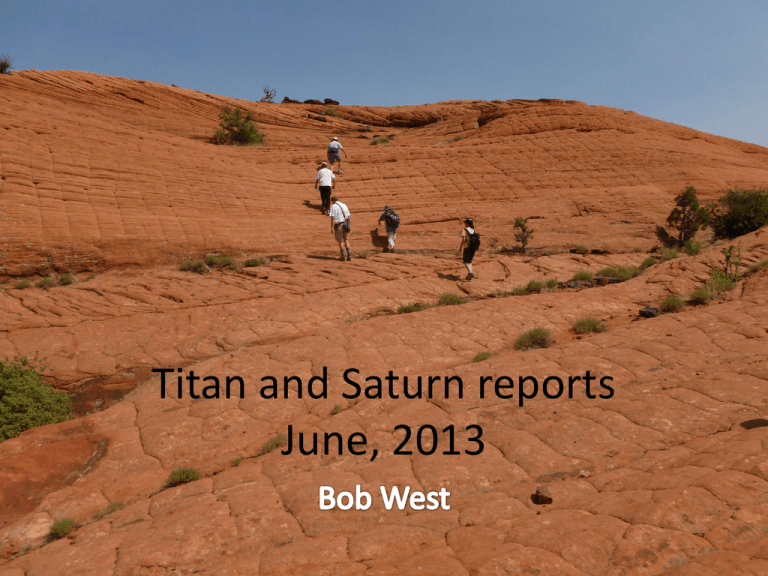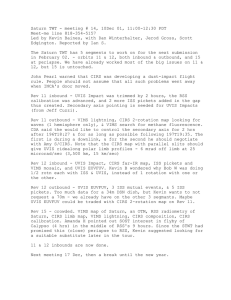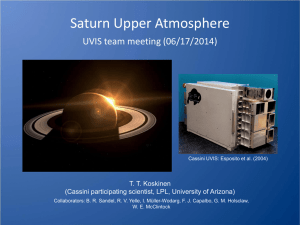Titan and Saturn reports June, 2013
advertisement

Titan and Saturn reports June, 2013 TOST agenda Tour Tweak exercise: TOST • Looked at two UVIS stellar occs affected by the tour tweak • Tweak moved one of the occs by about 40 minutes, but this can be accommodated Saturn Working Group and TWT Activity Tour Tweak exercise: Saturn • Looked at two UVIS PIE stellar occs affected by the tour tweak • Tweak moved the occs by only a few minutes – no problem • Discovered a bigger shift (about 30 min.) for one of the occs from a previous tour change that had not been recognized – need to get approval for the time change. Action Item for the TWTs/OSTS • 4. Science priorities and planning priorities for the F-ring and Proximal orbits – Bob West raised a concern about producing prioritized science goals for each discipline for the F ring and Proximal orbits prior to finalizing the science planning process for these orbits. The group also agreed that science priorities and planning should begin in preparation for the upcoming Senior Review. Linda Spilker agreed to generate action items for the Discipline Working Groups to address these concerns. Those action items are listed below: Saturn WG Response to Linda’s Action Item • Authored by Andy Ingersoll with input from the Saturn working group Prioritized Science Goals: Summary • Gravity (RSS) – Planetary formation, thermo-chemical evolution, internal structure, winds • Magnetic field (MAG) – Nature of the dynamo, rotation of the planetary interior • Exosphere composition (INMS) – Interaction with the lower atmosphere, magnetosphere, and rings • Stratosphere (UVIS & VIMS) – Stellar occultations to study waves, composition, aerosols, latitudinal transport of energy and constituents • Turbulence and small scales (RADAR, ISS, VIMS) – High resolution views to study unexplored scales of motion • Seasonal change – continue the campaigns to 2017 Gravity (from Luciano Iess) • Get even zonal harmonics out to J14 and tidal Love number k2 – determine mass of core, heavy elements in mantle, deep winds • Want 4 good orbits, 24 hours each - avoid HGA to ram, avoid Madrid to Canberra pass • Orbits 14 and 16 are the best • Compatible with INMS and MAG Magnetic field (MAG) and Exospheric composition (INMS) • The Saturn DWG strongly supports both of these objectives, but assumes that MAPS is taking prime responsibility • MAG is looking for non-axisymmetric features; needs calibration time, wants to avoid highspeed turns, but is compatible with other instruments • INMS requires –X to dust ram < 45° for major species, < 3° for reactive species and ions Triangles: already planned or executed Diamonds: outside 12 RS best for UVIS Squares: inside 12 RS Tightly-packed squares at the equator are best for VIMS Stellar Occultations (UVIS) • Occultations outside ± 12 hours (UVIS) – T and hydrocarbons, nbar to mbar; full latitude coverage allows estimates of horizontal transport of energy and chemical species; 3 dedicated orbits, 40-50 total occultations • CIRS observes occ point, extends profile down to 100’s of mbar; best at periapse. Study seasonal change, 15-20 year oscillation, overlap in vertical with UVIS. Stellar Occultations (VIMS) • Near periapse (VIMS) – Statistical variations of temperature within ± 1° of equator reveal stratospheric waves; 10-12 occs is ideal. Also good for determining He/H2 ratio (with CIRS); ~1 hour per occ, 3-9 hours from peri, any orbit • Distant occultations of brightest stars (VIMS) – probe deeper (to 20 mbar) than ever before; 6-7 occs total, α-Cma on Revs 275-279, α-Ori on Revs 271-276, ~1 hour per occ High resolution scans and views • 2.2 cm thermal emission (RADAR) – pole-topole scan reveals variations of ammonia vapor, want Z axis to Saturn on one orbit • Imaging of high-contrast regions (ISS) - can get ~0.1 km resolution with WAC; spatial power spectrum of atmospheric turbulence • Image polar vortex at 89° latitude (VIMS) image the hexagon at 75° latitude. Time dependence at all scales, hours to seasons Seasonal Change Campaigns – Completing the solstice mission to 2017 In these cases, full temporal coverage is more important than orbit geometry • Equatorial oscillation of temperatures and winds (CIRS) – like QBO of Earth but 15 years • Aurora – response to 11-year solar cycle and 30-year seasonal cycle (VIMS, UVIS, ISS) • Equatorial thermosphere (UVIS) – high T and large variability (388-612 K), still a mystery


